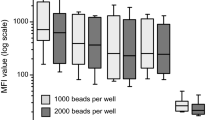Abstract
Immunological sensitivity and specificity properties of isolated Plasmodium falciparum (GPL) antigen from culture supernatant have been measured and compared with malarial antigens and non malarial filtered paper blood sera for potency and efficacy. Latex bead coded GPL, Pf and RESA antigens immunoreaction properties of human filter paper blood samples (FPB) were studied by laser light scattering immunoassay (LIA) and Enzyme linked immunoabsorbent assay (ELISA) techniques. Results of GP. antigen sensitivity study by LIA method showed a very high malaria antibody binding response (MABR) i.e. 6% compared with 78% with RESA and 88% Pf antigens. Malaria detection by ELISA method also found similar results. Specificity study of GPL antigen for different non malarial filter paper blood sera (NMFS) showed no immunoreaction however Pf and RESA antigen showed few positive immunological responses. These results suggest that sensitivity and specificity properties of isolated GPL antigen is better than other antigens.
Similar content being viewed by others
References
Antony, T., Saxena, A., Roy, K.B. and Bohidar, HB. 1998 Laser light scattering immunoassay: an improved data analysis by CONTIN method. J. Biochem Biophys Methods 36(2–3), 75–85.
Alaedini, A. and Latov, N. 2000 Detection of antiGMI Ganglioside antibodies in patients with Neurophathy by Noval Latex agglutination assay. J. Immuno. 21(4), 377–386.
Bhakat, P., Arati Roy and Kunal B. Roy 1999 Laser Light Scattering Immunoassay for Malaria J. Immunol. 20(3), 103–114.
Butler, D. 1997. Time to put malaria control on the blobal agenda. Nature 386 535–541.
Clendennen, T.E., Long, G. W. and Baird, J. K. 1995 QBC and Giemsa stained thick blood films diagnostic performance of laboratory technologists. Transactions of the Royal Sociaty of Tropical Medicine and Hygiene 89, 183–184.
David, J., Fryaufe Purnomo, Mochammad, A., Sutamihardja., Iqbal, R.S., Elyazar. Ika Susanti., Krisin, Budi Subianto. and Harijanl Marwoto. 2000 Performance of the OpotiMAL assay for detection and idendification of malaria infections in asymptomatic residents of Irian Jaya, Indonesia. Am. J. Trop. Med. Hyg. 63(3–4), 139–145.
Dietz, R., Perkins, M., Boulos, M., Luz, F., Reller, B. and Corey, C.R. 1995 The diagnosis of Plasmodium falciparum using a new antigen detection system. Am. J. Trop. Med. Hyg. 88, 187–188.
Frankenburg, S., Sllutzky, G.M., Gitler, C. and Lonhner, M.V. 1984 Lipid antigens derived from erythrocytes infected with Plasmodium falciparum. Zeitschrift Fiir Parasitenkunde 70, 331–335.
Garraud, O., Diouf, A., Nguer CM., Dieye, A., Longacre S., Kaslow DC., Holder A., Tall A., Molez JF., Perraut, R. and Mercereau Puijalon, O. 1999 Dofferential in vitro stimulation of T lymphocytes using Pfalciparum MSP119 antigens in individuals from different endemic areas, Scand. J. Immunol. 97, 204–210.
George, J., Giburd, B., Langevitz, P., Levy, Y., Nezlin, R., Harats, D. and Shoenfild, Y. 1999 β2 glycoprotein-1 containing immune-complexes in lupus patients: associated with thrombocytopenia and lipoprotein (a) levels. Lapus 8, 116–120.
Hang, V.T., Be, T.V., Tran, P.N., Thanh, L.T., Hien, L.V., O'Brine, E. and Morris, G.E. 1995 Screening donor blood for malaria by polymerase chain reaction. Transactions of the Royal Society of Tropical Medicine and Hygiene 89, 44–47.
Humar, A., Ohrt, C., Harrington, M.A., Pillai, D. and Kain, K.C. 1997 ParaSight F test compared with the polymerase chain reaction and microscopy for the diagnosis of Plasmodium falciparum malaria in travelers. American Journal of Tropical Medicine and Hygiene 56, 44–48.
Kabat, E.A. and Mayer, M.M. 1961 Experimental immunochemistry, C.Thomas, Springfield, Illinois.
Kaslow, DC., Hui, G. and Kumar, S. 1994 Expression and antigenicity of Plasmodium falciparum major merozoite surface protein-1 (MSP119) variants secreted from Saccharomyces cerevisiae. Mol. Biochem. Parasitol. 63, 283–289.
Kawamoto, F. 1991 a Rapid diagnosis of malaria by fluorescence microscopy with light microscopy and interference filters. Lancet I, 200–202.
Lowe, B.S., Jeffa, N.F., New, L., Pedersen, C., Engbaek, K. and Marsh, K. 1996 Acridine orange fluorescence techniques as alternatives to traditional Giemsa sttaining for the diagnosis of malaria in developing countries. Transactions of the Royal Society of Tropical Medicine and Hygiene 90, 34–36.
Makler, M.T., Palmer, C.J. and Ager, A.L. 1998 A review of practical techniques for the diagnosis of malaria. Annals of Tropical Medicine and Parasitology 92 (4), 419–433.
Nezlin, R. 2000 A quantitative approach to the deteln1ination of antigen in immune complexes. J. Immunol. Methods 237, 1–17.
Mya, M. M., Roy, A. and Saxena, R.K. Isolation, part characterization and antigenecity of a glycophospholipid from Plasmodium falciparum culture supernatant. (Unpublished data: Sent for publication in Current Science).
McDougal, J.B. and McDuffie, D.C. 1985 Immune complexes in man detection and clinical significance, Adv. Clin. Chem. 24, 1–60.
Palmer, C.J., Lindo, J.F., Klakala, W., Quesada, J., Kaminsky, R. and Ager, A.L. 1998. Evaluation of the OptiMAL test for rapid diagnosis of Plasmodium vivax and Plasmodium falciparum malaria. J. Clin. Microbiol. 36, 203–206.
Peyron, F.G., Martet, J.P. and Vigler, A. 1994 Dipstick antigen-capture assay for malaria detection. Lancet I, 1502–1503.
Quarles, R.H. and Dalakas, M.C. 1996 Do anti-Glycolipid antibodies cause human peripheral neuropathies?. J. Clin. Invest. 97, 1136–1137.
Roy, A., Biswas, S., Kabilan, L. and Sharma, V.P. 1995 Application of simple peptede ELISA for stratification of malaria endemicity. Indian J. Malariology 32, 164–173.
Trager, W. and Jenson, J.B. 1976 Human malaria parasites in continuous culture. Science 193, 673–675.
Van Oss, C.J. 1994 Nature of specific ligand-receptor bonds, in particular the antigen-antibody bond. In: Van Oss C.J. and van Regenmortel, M.H.V. (Eds), Immunochemistry, Marcel Dekker, New York, pp 581–614.
Vial, H.J., Thuet, M.J. and Philippot, J.R. 1982 Phospholipid biosynthesis in synchronous Plasmodium falciparum antigen efficiently inhibit merozoit invasion Proceedings of the National Academy of Sciences, USA. 81, 7912–7916.
Warhurst, D.C. and Williams, J.E. 1996. Laboratory diagnosis of malaria. Journal of Clinical Pathology 49, 533–538.
Author information
Authors and Affiliations
Corresponding author
Rights and permissions
About this article
Cite this article
Mya, M.M., Saxena, R.K. & Roy, A. Sensitivity and specificity of isolated antigen fromPlasmodium falciparum culture supernatant. Indian J Clin Biochem 17, 75–82 (2002). https://doi.org/10.1007/BF02867946
Issue Date:
DOI: https://doi.org/10.1007/BF02867946



